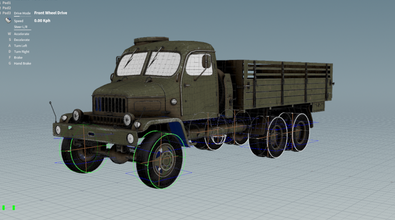Nick Petit
npetit
About Me
Connect
LOCATION
Not Specified
WEBSITE
Houdini Skills
Availability
Not Specified
My Badges

SideFX Staff
Since Feb 2008
Recent Forum Posts
Point constrain in Solaris Jan. 31, 2025, 12:43 a.m.
You can use the different * Constraint LOPs to do just that.
Depending on whether your light geometry has animated transforms or is deforming geometry, you can use a Parent Constraint LOP in the former case, or a Points Constraint LOP in the latter.
When you have "Maintain Local Offset" enabled, it allows you to keep the light's local transform, so if you constrain the light to your lamp geometry, display the output of the constraint and select the light and move it around until it sits exactly where you want it.
Or you can simply create the light under an Xform prim, constrain this Xform prim to the lamp geo and then move the light around however you want after the constraint - this makes adding the offset a lot simpler.
Here's an example with a few different options.
Depending on whether your light geometry has animated transforms or is deforming geometry, you can use a Parent Constraint LOP in the former case, or a Points Constraint LOP in the latter.
When you have "Maintain Local Offset" enabled, it allows you to keep the light's local transform, so if you constrain the light to your lamp geometry, display the output of the constraint and select the light and move it around until it sits exactly where you want it.
Or you can simply create the light under an Xform prim, constrain this Xform prim to the lamp geo and then move the light around however you want after the constraint - this makes adding the offset a lot simpler.
Here's an example with a few different options.
Apply different material and shading to each copy instance Jan. 10, 2025, 11:57 p.m.
You can prep most of it in SOPs without doing much in LOPs at all. The SOP Create LOP has a button to automatically detect and assign materials.
Here's an example showing how you can assign different materials to different instances (an example for native and for point instances) as well as getting variations in materials by using primvars (SOP attribs) to drive the material look.
Here's an example showing how you can assign different materials to different instances (an example for native and for point instances) as well as getting variations in materials by using primvars (SOP attribs) to drive the material look.
Material variation questions Jan. 3, 2025, 5:44 p.m.
The Material Variation node doesn't need materials to be created at any particular point - in fact it doesn't need to know anything about the materials at all. It does try to find materials that are assigned to the instances in order to find input names and types to populate the drop down menu for the primvar names, but nothing prevents you from creating the primvars manually.
What determines whether a primvar will have an effect on the material, as long as the material has a way to read the given primvar of course, is where the primvar is authored.
On point instances, the Material Variation LOP will author the primvars on the point instancer prim. These will override inherited primvars and overwrite primvars of the same name on the point instancer.
If you have primvars authored on the prototype prims however, these will take precedence.
What determines whether a primvar will have an effect on the material, as long as the material has a way to read the given primvar of course, is where the primvar is authored.
On point instances, the Material Variation LOP will author the primvars on the point instancer prim. These will override inherited primvars and overwrite primvars of the same name on the point instancer.
If you have primvars authored on the prototype prims however, these will take precedence.

